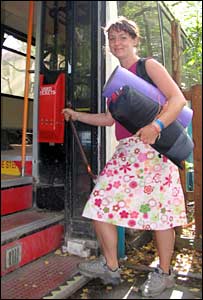An UK environmental campaigner has established one of this week's most popular blogs by chronicling her journey to Australia using only surface transport, but has been forced to revise initial claims that air transport was four times as damaging to the environment as trains and buses.
The UK press covered the story of Barbara Haddrill, a bridesmaid at a wedding in Brisbane, who was put off by the environmental impact of the 17,000km (9,200nm) flight, in its inimitable style. Instead of flying, she is travelling the route from her home in Machynlleth, Powys, central Wales to the Queensland capital by bus, train and boat. Many papers reprinted the activist's initial claims that air travel was four times as damaging in terms of emissions of carbon dioxide (CO2). However, combining data from Flight's stablemate Railways Gazette with advanced long-distance aircraft emissions calculations from the Air Transport Action Group show this figure to be exagerated.
Haddrill will travel by Eurolines coach to Moscow, via London, Warsaw and Minsk, a distance of over 3,500km (2,160 miles). From there she will pick up the Mongolian branch of the Trans-Siberian Railway to Beijing, covering 9,258km. In the Chinese capital she will pick up a train to Singapore, which is replaced by a bus service between Hanoi and Nougkhai on the Thai border for a total distance of 3750km. The final leg will see Haddrill hop on a cargo ship as crew on the leg to Darwin via several Indonesian ports, taking in 3,800km, followed by a return to long-distance coach covering the final 3,500km to Brisbane.
There are a multitude of multiples in performing a calculation like this. However, working on assumptions from the Swiss university Ecole Polytechnique fédérale de Lausanne's transport department, the average CO2 emissions for the trains, which use a mix of electric rolling stock on the Russian services and diesel locomotives on the majority of the Asian sectors, would be around 73g per passenger kilometre. Bus and coach travel would be lower, at 60g/pax-km. However, once inefficient Russian electricity generation, polluting Asian buses and connecting taxi journeys is taken into account, the surface route looks less impressive. Combined with an accurate calculation of modern long-haul aircraft with high load factors flying and unaffected by Extended Twin Engine Operations rules, the gap narrows even more.  In an update to her blog, the eco activist, whose part-time job is as a train driver and at the pressure group Centre for Alternative Technology's office, estimates the total emissions for her journey to be 1.62t of carbon dioxide. She compares this with 3.7t for a journey from London Heathrow to Brisbane via Singapore on a Boeing 747-400, making aviation only three times worse in terms of CO2 emissions.
In an update to her blog, the eco activist, whose part-time job is as a train driver and at the pressure group Centre for Alternative Technology's office, estimates the total emissions for her journey to be 1.62t of carbon dioxide. She compares this with 3.7t for a journey from London Heathrow to Brisbane via Singapore on a Boeing 747-400, making aviation only three times worse in terms of CO2 emissions.
However, the journey will take around six weeks rather than the 22h schedule employed by airlines operating the kangaroo route.
External link:
Read the progress of UK environmental campaigner Barbara Haddrill as she attempts to travel between the UK and Australia using only surface transport in her blog.
Source: FlightGlobal.com



















